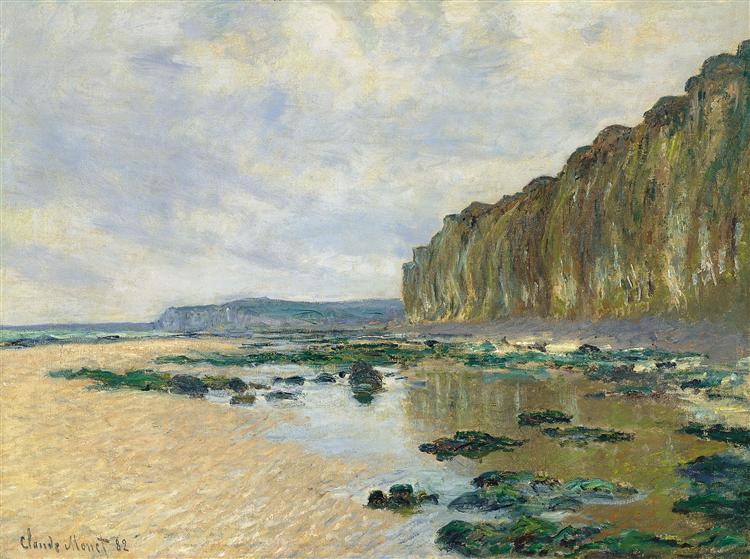Beschrijving
Claude Monet's painting "Low Tide at Varengeville" (1882) offers a captivating view of the interplay between nature and light, intrinsic characteristics of the Impressionist movement. This work captures a fleeting instant, a moment when the tide is receding, revealing the texture and colours of the Normandy coast. Monet, one of the most emblematic figures of Impressionism, strives in this work to capture the essence of the French landscape, where the atmosphere and the play of light transform the viewer's perception.
The composition of “Low Tide at Varengeville” is organized in a way that emphasizes the horizontality of the seascape. The use of horizontal lines provides a sense of vastness and calm, where the coast gently unfolds beneath a blue-grey sky. The hues used, which range from deep blues to light greys, are characteristic of Monet’s style, who sought to reproduce the light and colour of the natural scene in its purest state. The loose, gestural brushwork is characteristic of the artist, allowing the viewer to feel the freshness of the sea air and the fluidity of the water.
A notable presence in this work are human figures, though they are not the main focus. Two small silhouettes stand on the shore, looking out over the landscape, adding a dimension of scale to the painting. These almost elusive figures embody man’s intimate relationship with nature, reminding us of the fragility and temporality of the human experience in contrast to the vastness of the landscape. Furthermore, their sparse definition highlights the painting’s atmosphere and the way the artist chooses to focus on light and color rather than specific details.
The colour palette in “Low Tide at Varengeville” is sublime and nuanced. Monet employs a combination of cool and warm tones, which blend together and can be seen in his brushstroke technique, which is often quick and light. This creates a vibrant effect evoking the movement of water and sky. The reflections on the water’s surface are particularly noticeable, where the hues of the sky are doubled, suggesting a continuity between sea and atmosphere.
The choice of Varengeville as a location is also significant. Monet had a deep personal connection with the region, where he spent important periods of his life and where many of his works were conceived. The painting reflects his desire to capture the changing light and nuances of the environment, a recurring theme in his work. Varengeville, with its rugged coastline and dramatic landscapes, became a place of experimentation for Monet, where he focused on the changing effects of light and colour.
In a broader context, Low Tide at Varengeville can be seen as part of Monet's transition from more traditional landscape painting towards a more radical exploration of visual perception and atmospheric conditions. Its focus on light, colour and the capture of ephemeral moments aligns with the broader concerns of Impressionism, which seeks to free art from academic conventions.
Through “Low Tide at Varengeville,” Monet not only offers us a beautiful landscape, but also captures the essence of the moment when nature and light intertwine, challenging the viewer to feel and experience the same wonder that he experienced when painting this scene. The work resonates as an enduring testament to Monet’s mastery in capturing light and atmosphere, cementing him as a central figure in art history.
KUADROS ©, a famous painting on your wall.
Hand-made oil painting reproductions, with the quality of professional artists and the distinctive seal of KUADROS ©.
Painting reproduction service with satisfaction guarantee. If you are not completely satisfied with the replica of your painting, we will refund 100% of your money.

